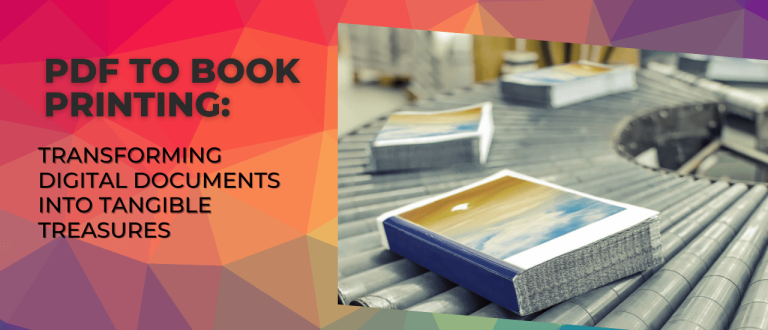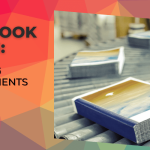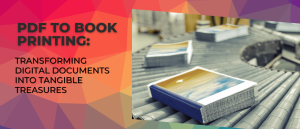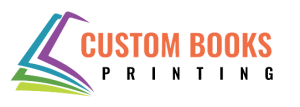Table of Contents
ToggleOverview of the Process of PDF to Book Printing:
The PDF to book printing process offers an interesting twist, taking a digital document and turning it into a tangible, physical book. In our increasingly digital world, this process bridges the gap between the convenience of digital files and the timeless appeal of printed books. Understanding this process overview allows us to appreciate the artistic and technical aspects involved in bringing digital documents to life in action.
Converting a PDF to a printed book involves several key steps, each of which contributes to the final result. From creating a digital document to choosing a printing service, reviewing print proofs and finalizing printing details, every step plays a vital role in ensuring the quality and aesthetic appeal of the finished book. This process allows individuals, authors, and businesses to share their work, ideas, and stories in a format that engages readers on a physical level.
By examining the PDF to book printing process, we can gain insight into the complexities of turning digital files into tangible treasures. From the technical considerations of file formatting and optimization to choosing a reliable printing service and the final stages of binding and packaging, every step contributes to achieving a physical book that can be loved, displayed and can be shared with others.
In the following sections, we’ll take an in-depth look at each step of the process, providing valuable information and guidance for those looking to start their PDF to book printing journey. Whether you’re an author looking to self-publish your manuscripts, a business creating marketing materials, or an individual looking to preserve cherished memories, understanding the process overview will help you turn your digital documents into attractive printed books. Will give the authority to do that which actually exist.
Why Converting PDF to Physical Books:
In an increasingly digital age, where information is easily accessible at our fingertips, the desire to convert PDFs (Portable Document Format) into physical books or PDF to Book Printing, may seem counterintuitive. However, there are compelling reasons why this change is considered desirable and has a particular appeal to individuals, businesses, and authors.
While digital documents offer convenience and efficiency, there’s something undeniably appealing about holding a physical book in your hands. The process of converting PDFs to physical books connects our natural connection with the tangible world and provides many unique benefits and experiences.
First and foremost, physical books offer a sensory experience that digital formats cannot replicate. The weight, texture, and smell of the pages create a multi-sensory encounter that enhances the reading and browsing experience. Flipping through physical pages, underlining important passages, and bookmarking favorite sections creates a sense of nostalgia and intimacy that creates a deeper connection with the content.
Converting PDFs to physical books or PDF to book printing also provides a tangible representation of one’s work or ideas. Whether it’s a personal memoir, a professional portfolio, or a collection of essays, having a physical book shows the effort, creativity, and skill that went into its creation. Physical books have an enduring quality that can be valued and displayed on shelves, making a lasting impression on readers and serving as symbols of success.
Additionally, physical books provide a respite from the digital distractions that permeate our lives. In a world filled with screens and constant connectivity, a physical book provides an opportunity to disconnect, focus and engage with content in a more immersive and uninterrupted way. It allows for deeper levels of understanding, reflection and enjoyment, providing refuge from the fast-paced digital realm.
Additionally, physical books have sentimental value. They can be passed down through the generations, becoming heirlooms that preserve family stories, traditions and memories. A physical book serves as a solid link to the past, creating a sense of continuity and connection with our personal and collective history.
When it comes to converting a digital document, such as a PDF, into a physical book, an important step is to assess the layout and design of the original file. This involves carefully reviewing various aspects of the document to ensure that it translates effectively into the printed book.
Assessing the layout and design of the digital document:
- Page Orientation and Size: Determine if the document is designed for portrait or landscape orientation. Consider the dimensions of the pages and make sure they fit the size of the intended book. This evaluation ensures that the content fits properly on the printed pages without clipping or distortion.
- Margins and Blades: Check the margins — the spaces around the edges of the document — to make sure they are consistent and provide enough breathing space for the content. Additionally, if any images or elements extend beyond the page boundaries, a blade area must be added to accommodate them during the printing process.
- Fonts and Typography: Examine the choice of fonts and their rationality in the context of print. Consider whether the chosen fonts are suitable for long-form reading and if they maintain readability at the desired book size. Evaluate font size, line spacing, and paragraph formatting to ensure comfortable reading experiences.
- Images and Graphics: Review the quality and resolution of images and graphics within the document. Verify that they have sufficient resolution for print and will reproduce well on physical pages. Check if any adjustments need to be made to image placement, scaling, or alignment to ensure they enhance the overall visual appeal of the printed book.
- Color Considerations: If the original document contains color elements, estimate how they will translate to print. Keep in mind that colors may appear differently on paper than on a digital screen. Assess color accuracy and vibrancy, and decide if any adjustments are needed to ensure the desired visual impact in the printed book.
- Consistency and Readability: Ensure consistency in layout and formatting throughout the document. Verify that headings, subheadings, and body text are appropriate and consistent in font, size, and formatting. Assess the overall readability of the text by considering factors such as line length, leading and paragraph spacing.
Choosing the Right Printing Service:
Researching and Comparing Different Printing Services:
When embarking on the journey of converting a digital document into a physical book, an important step is to research and compare different printing services. The choice of printing service plays an important role in determining the quality, aesthetics and overall satisfaction of the final printed book. By doing thorough research and making informed comparisons, you can ensure that your project gets the attention and expertise it deserves.
Researching and comparing different printing services allows you to gauge their capabilities, offerings, and reputation. This empowers you to make an educated decision, choosing a printing service that suits your specific needs and desires. Whether you’re a self-published author, a small business owner, or someone looking to create personalized keepsakes, finding the right printing service is critical to achieving a professional and visually stunning end result.
During your research, several important factors come into play. Printing quality is a primary consideration, as you want your book to display crisp, vibrant, and accurately reproduced text and images. It’s also important to evaluate the paper options offered by different services, as the type and finish of the paper greatly affects the experience and durability of a spray-printed book.
Additionally, customization options and add-ons can add personalization and uniqueness to your project. From cover finishes to special binding techniques, these options allow you to create a book that stands out and grabs attention.
Cost and turnaround time are also practical considerations for equilibrium. While cost is important, it’s crucial to find a printing service that offers competitive pricing without compromising on quality. The turnaround time should fit your project timeline, ensuring that your book is printed and delivered within the required time frame.
Additionally, researching customer reviews and testimonials provides insight into the reliability, customer service, and overall satisfaction experienced by previous clients. Hearing from others who have used printing services can help you make an informed choice and build confidence in your decision.
By focusing on additional services offered, such as proofreading or graphic design assistance, you can streamline your workflow and ensure a polished final product.
Evaluating the Options for Paper Quality, Binding, and Finishes:
When it comes to creating a physical book, evaluating paper quality, binding, and finishing options is an important step in ensuring a visually stunning, durable, and enjoyable reading experience. These elements play an important role in shaping the overall look, feel and functionality of the complete book. By carefully evaluating and selecting the right choices for paper, binding, and finishing, you can take your book to new levels of aesthetic appeal and quality.
The quality of paper used in your book has a profound effect on both its tactile experience and durability. Factors such as paper weight, texture, and color contribute to the overall feel and visual impression. Whether you prefer a luxurious heavy stock paper that exudes elegance or a lightweight option for a more economical approach, choosing the right paper is essential. Consider the texture of the paper, as it can enhance the reading experience and add a touch of individuality. The color of the paper can also affect the overall atmosphere and complement the content of your book.
Binding options are another important consideration in creating a well-designed book. The binding method determines how the pages are held together and affects the structure and flexibility of the book. Perfect binding, saddle stitching, and case binding each offer distinct advantages and limitations. Perfect binding, with its glued pages and flexible cover, is commonly used for paperback books. Saddle stitching, where the pages are folded and stapled along the spine, is suitable for thin publications such as booklets or magazines. Case binding provides durability and a sophisticated appearance, making it ideal for hardcover books.
Additionally, the finishes applied to your book can enhance its visual appeal and protect it from wear and tear. Coatings such as matte or glossy varnish provide different levels of gloss and protection to covers and pages. Varnishes or laminates offer an extra layer of defense against scratches and moisture. Finishing techniques such as spot UV coating or embossing can add texture and highlight specific design elements, creating a visually striking effect.
By carefully considering paper quality, binding and finishing options, you can create a book that not only showcases your content but also captivates readers with its aesthetic appeal and durability. Each choice contributes to the overall experience and impression of your book, ensuring it stands out on bookstore shelves or in the hands of readers. So, take the time to explore and consider the various options available, and make informed decisions that align with your vision and goals.
The Printing Process of converting PDF to Book:
Submitting your PDF to the chosen Printing Service
Once you have gone through the process of researching, comparing and selecting the ideal printing service for your PDF to book printing project, the next step is to submit your PDF to the selected printing service. This important step marks the transition from the digital realm to the physical production of your book. By submitting your PDF to a printing service, you begin the process that will bring your creation to life in reality.
Submitting your PDF to a selected printing service involves providing them with a digital file of your book, along with any specific instructions or requirements you may have. This step allows the printing service to prepare and optimize your PDF for the printing process. Whether you’ve carefully designed the layout, added images, or formatted the text, it’s important to make sure your PDF is prepared correctly before submission.
During this step, it is recommended that you review your PDF carefully to verify that it accurately represents your desired end product. Double-check elements such as page numbers, headers, footers, margins, fonts and other design aspects to ensure consistency and accuracy. It’s also a good idea to proofread the content again to catch any long errors or typos that may have been missed.
Additionally, any guidelines or specifications provided by the printing service regarding file formats, color profiles, image resolutions, or any other technical requirements must be followed. Following these guidelines ensures a smooth and successful printing process, reducing the chance of any problems or unexpected results.
Submitting your PDF to your chosen printing service is an exciting step because it signifies that your vision and hard work is about to turn into a physical book. This marks the beginning of the production phase, where experienced professionals will use advanced printing technology and techniques to turn your digital document into a beautifully printed and bound book.
By entrusting your PDF to a selected printing service, you can be sure that your project is in capable hands. A printing service will handle technical intricacies, such as color calibration, paper selection, and binding, to deliver a high-quality printed book that reflects your original vision.
Reviewing and Approving Print Proofs
As you progress through the process of turning your PDF into a physical book, an important step is reviewing and approving print proofs. Print proofs serve as a clear representation of your book, allowing you to review its layout, design, color, and overall quality before final production. This step provides an invaluable opportunity to ensure that your vision is accurately translated onto the printed pages and make any necessary adjustments before finally moving forward.
Reviewing and approving print proofs is an important quality control step that ensures the end result meets your expectations and specifications. This allows you to carefully review every aspect of the book, from the placement of text and images to the accuracy of colors and the alignment of elements. By closely reviewing print proofs, you can catch any potential errors, inconsistencies, or design issues that may have been overlooked in digital format.
During this step, it’s important to pay attention to details such as font style and size, paragraph placement, image resolution, and any graphic elements. Check for any typographical errors, formatting errors, or artifacts that may have occurred during the printing process. Assess the overall readability and visual appeal of printed pages, ensuring that text is crisp and clear, and images are sharp and well reproduced.
Comparing print proofs to your original PDF is also important to ensure that layout, pagination, and other design elements are correctly translated from the digital file to the physical book. Verify that page numbers, headers, footers and any special formatting features are applied correctly.
Additionally, consider the color accuracy of print proofs, especially if your book contains images or uses specific color schemes. Compare the printed colors to the original digital version and assess whether they match your desired visual presentation.
Reviewing and approving print proofs empowers you to make informed decisions and collaborate with the printing service to achieve the desired result for your PDF to Book Printing. If any problems or inconsistencies are found, clearly and promptly notify the printing service, providing specific instructions for necessary modifications or adjustments.
By diligently reviewing and approving print proofs, you ensure that the final printed version of your book reflects your artistic vision, meets your quality standards, and Resonates with your target audience. This is an important step in PDF to book printing process that allows you to fix details and guarantee satisfactory and visual.
Enhancement in Printed Books:
Exploring additional options like Book Cover Design and customization opens up a world of creative possibilities for your PDF to Book Printing process. Apart from content and layout, the cover plays an important role in attracting readers and conveying the essence of your book. This step allows you to review various aspects of cover design, including imagery, typography, colors and finishes, to create a visually impressive and attractive cover that captures the essence of your work.
Cover design has immense power to pique the curiosity of potential readers and entice them to pick up your book. It acts as a visual representation of the story or topic, evoking emotions and setting expectations. By exploring different design elements, such as choosing an appealing image or illustration, incorporating great typography, and coordinating color schemes, you can create a cover that resonates with your target audience. You are buzzing.
Customization adds to the uniqueness and personalization of your book. This allows you to add special touches or tailor certain elements to align with your vision and brand. Consider options like foil stamping, embossing, debussing, or spot UV coating to add texture, depth, and visual interest to the cover. These customizations can enhance the aesthetic appeal of your book, making it stand out on bookstore shelves or online catalogs.
During this stage, it’s critical to align cover design and customization choices with your book’s style, theme, and intended audience. For example, a sleek and minimalist design might work well for a contemporary novel, while a vibrant and illustrative cover might be more appropriate for a children’s book. Consider the expectations and preferences of your target readers to create a cover that resonates with them.
Exploring additional options like cover design and customization not only enhances the visual appeal of your book but also adds a personal touch that sets it apart from others. This allows you to add your creativity and vision to every aspect of the book, creating a truly unique and immersive reading experience for your audience.
Adding Special Features such as Bookmarks, Embossing, or Foiling in PDF to Book Printing:
Adding special features such as bookmarks, embossing, or foiling to your printed book enhances its aesthetic appeal and creates an enjoyable reading experience for your audience. These additional elements go beyond the standard book look, offering unique touches that elevate the overall quality and make your book truly stand out.
Bookmarks serve as a practical and decorative addition, allowing readers to easily mark their progress or favorite pages. They provide convenience and add beauty to the reading experience. Whether it’s a simple ribbon bookmark or a custom design featuring your book’s logo or artwork, this feature adds functionality and appeal.
Embossing is a technique that creates an embossed pattern or design on a book cover, adding texture and visual interest. It conveys a sense of sophistication and luxury, making your book feel more important and appealing. Embossed elements can include titles, logos, or intricate patterns, creating an experience that engages the reader before even opening the book.
Foiling, on the other hand, involves applying metallic or colored foil to the book cover or parts of the text. This technique adds a dramatic glow, grabs the reader’s attention, and emphasizes key elements. Foiling can be used to highlight titles, borders or specific design elements, giving your book a luxurious and attractive appearance.
These special features not only enhance the aesthetics but also contribute to the overall reading experience. They create a sense of hope and excitement, making the book feel like a precious treasure. Additionally, they can leave a lasting impression on readers, make your book more memorable and increase its perceived value.
When considering adding special features like bookmarks, embossing, or foiling, it’s important to align them with your book’s theme, genre, and target audience. Each feature should complement the content and contribute to the overall narrative or visual presentation.
Conclusion:
Finally, PDF to book printing is a remarkable process that transforms digital documents into tangible treasures. It allows individuals to bridge the gap between the digital and physical worlds, bringing their ideas, stories, and creations to life in a professional and visually appealing way. By exploring the different stages of the process, from assessing layout and design to paper quality and finishing, individuals can ensure that their printed books meet their vision and expectations.
The increasing importance of digital documents in the modern age makes PDF to book printing a desirable option for those who want to preserve and exhibit their work. The ability to transform digital files into beautifully printed books not only adds a sense of consistency and authenticity, but also allows for customization and personalization that reflects the creator’s unique style and voice.
Throughout the process, research and compare different printing services, evaluate options for paper quality, binding, and finishes, review and approve print proofs, and additional features such as cover design and customization. All these contribute to the creation of a truly exceptional book. These steps ensure that every aspect of the final product is carefully considered and optimized.
PDF to book printing is an opportunity for individuals to embark on a creative journey, turning their digital documents into tangible treasures that can be treasured and shared with others. Whether it’s a novel, a portfolio, or a collection of photos, this process allows individuals to turn their projects into professional-looking books that make a lasting impression.
By embracing the possibilities of book printing from PDF, individuals can unleash their creativity, elevate their work, and make a meaningful impact. It opens the door to self-expression, independent publishing, and reaching a wider audience. The satisfaction of having a physical book filled with your words, images and thoughts is a testament to the power of PDF book printing to turn digital documents into tangible treasures that can be enjoyed for years to come.
In a world increasingly dominated by digital media, PDF-to-book printing reminds us of the enduring appeal and value of physical books. It allows us to appreciate the tactile experience, the joy of turning pages, and a deeper connection with content. With PDF to book printing, we can transform our digital documents into truly valuable artifacts that will continue to inspire and inspire readers for generations.














